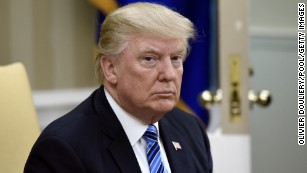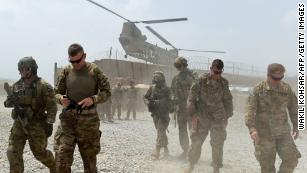Trump calls for Pakistan, India to do more on Afghanistan
(CNN)US President Donald Trump had tough words for Pakistan Monday, as he attempted to steer a new approach on Afghanistan.
"We can no longer be silent about Pakistan's safe havens for terrorist organizations," he said in a speech at Fort Myer in Arlington, Virginia.
"We have been paying Pakistan billions and billions of dollars, at the same time, they are housing the very terrorists we are fighting ... that must change immediately."
He also called on Pakistan's regional rival India, to "help us more with Afghanistan, especially in the area of economic assistant and development."
"We appreciate India's important contributions to stability in Afghanistan but India makes billions of dollars in trade from the United States and we want them to help us more with Afghanistan, especially in the area of economic assistance and development."
Tough talk
Washington has long accused Islamabad of not doing enough in efforts to stabilize Afghanistan.
In July, Secretary of Defense James Mattis informed Congress the US was withholding $50 million in funding from Pakistan because he was unable to certify that Islamabad "has taken sufficient action against the Haqqani Network," a branch of the Afghan Taliban.
US officials believe that much of the Haqqani leadership is based in Pakistan and some analysts believe eliminating their safe havens is critical to stabilizing Afghanistan.
Trump seemed to reference this in his speech Monday, saying that "Pakistan has much to gain from partnering with our effort in Afghanistan (and) much to lose from harboring criminals and terrorists."
Afghanistan: 16 years, thousands dead and no clear end in sight
Pakistan was designated a major US non-Nato ally by President George W Bush in 2004, in recognition for Islamabad's contributions to the anti-Al Qaeda fight, but relations between Washington and Islamabad have long been strained over Afghanistan.
"Pakistan has ironclad immutable strategic interests which dictate maintaining ties to groups like the Taliban," said Michael Kugelman, deputy director and senior associate for South Asia with the Asia Program at the Woodrow Wilson Center.
"It sees them as useful tools to keep Pakistan's enemy, India, at bay in Afghanistan."

US troops in Afghanistan: A history 01:27
Pakistan policy
In 2009, President Barack Obama announced a "comprehensive, new strategy for Afghanistan and Pakistan"
"The future of Afghanistan is inextricably linked to the future of its neighbor, Pakistan," Obama said, calling on Islamabad to "demonstrate its commitment to rooting out al Qaeda and the violent extremists within its borders."
Eight years later, however, little has changed. A report earlier this year by the conservative Hudson Institute found "Pakistan never changed its policy of supporting certain militant groups that fight Afghan and coalition forces, thus making it impossible for the United States to achieve its objective of keeping Afghanistan from reverting to a safe haven for international terrorism."
Al Qaeda leader and 9/11 attack planner Osama bin Laden was hiding out in Pakistan when he was assassinated by US soldiers in May 2011 -- the White House did not inform Islamabad about the raid until it was over, embarrassing the country's military and raising questions over the two nations' security relationship.
Trump repeatedly mentioned the 9/11 attack as the reason for US action in Afghanistan during his speech.
However, what the President will do to ensure Pakistan does change its behavior is unclear, said Kugelman. Tactics could include cutting aid and curtailing military assistance to Islamabad, he added.
"A review of whether Pakistan should be considered a state sponsor of terrorism -- a draconian measure -- should not be ruled out if conditions don't improve," Brookings Institute Pakistan analyst Bruce Riedel said in February.
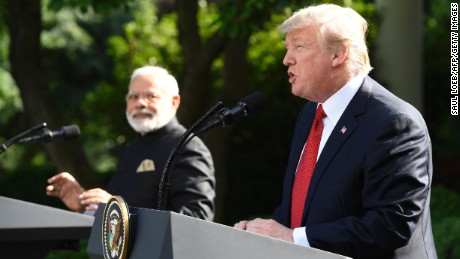
Trump: Relations with India better than ever 07:17
India engagement
Concerns in Islamabad will be heightened not only by Trump's criticism of Pakistan, but also his reaching out to India.
In June, Trump called India a "true friend" following a meeting with Prime Minister Narendra Modiand said relations between the two countries have "never been stronger ... never been better."
But Trump seemed to indicate that friendship would not be without conditions Monday. "India makes billions of dollars in trade from the United States, and we want them to help us more with Afghanistan," he said.
Trump had similar expectations for other powers. "We will ask our NATO allies and global partners to support our new strategy with additional troop and funding increases in line with our own," he said.
"Since taking office, I have made clear that our allies and partners must contribute much more money to our collective defense, and they have done so."
In a statement prior to Trump's speech, US Secretary of State Rex Tillerson said India "will be an important partner in the effort to ensure peace and stability in the region, and we welcome its role in supporting Afghanistan's political and economic modernization."
Greater Indian involvement in Afghanistan doesn't only put it in competition with Pakistan, but also China, which has been investing heavily in both countries as part of its "One Belt, One Road" economic program.
China is Afghanistan's third largest trading partner, with bilateral trade reaching over $1 billion by 2015, according to the Central Statistics Office of Afghanistan. Beijing is also investing upwards of $46 billion in the China-Pakistan Economic Corridor (CPEC).
Relations between India and China have become strained in recent months amid an ongoing territorial dispute in the Himalayas.
Trump did not mention China once during his speech Monday.
Photos: Afghanistan: America's longest war
US soldiers disembark from a helicopter in Afghanistan's Ghazni Province on May 28, 2007.
Hide Caption
21 of 40
Photos: Afghanistan: America's longest war
Supplies are dropped to US troops in Ghazni Province on May 29, 2007.
Hide Caption
22 of 40
Photos: Afghanistan: America's longest war
Afghan students recite Islamic prayers at an outdoor classroom in the remote Wakhan Corridor on September 2, 2007.
Hide Caption
23 of 40
Photos: Afghanistan: America's longest war
Troops wait to fire artillery on a Taliban position in Afghanistan's Kunar Province on October 22, 2008.
Hide Caption
24 of 40
Photos: Afghanistan: America's longest war
Bush speaks to US troops during an unannounced visit to Bagram Air Base on December 15, 2008. It was his second and last visit to Afghanistan as President.
Hide Caption
25 of 40
Photos: Afghanistan: America's longest war
US soldiers take defensive positions after receiving fire from Taliban positions in Afghanistan's Kunar Province on May 11, 2009. Army Spc. Zachary Boyd, left, was wearing "I love NY" boxer shorts after rushing from his sleeping quarters to join his fellow platoon members.
Hide Caption
26 of 40
Photos: Afghanistan: America's longest war
Afghan men cast their votes at a polling station in Kabul on August 20, 2009. It was the country's second election.
Hide Caption
27 of 40
Photos: Afghanistan: America's longest war
US Marines make their way up a mountainside in Afghanistan's Helmand Province on August 22, 2009.
Hide Caption
28 of 40
Photos: Afghanistan: America's longest war
Marines pay their respects to Lance Cpl. Joshua Bernard during his memorial service in Helmand Province on August 27, 2009. Bernard was killed during a Taliban ambush earlier that month.
Hide Caption
29 of 40
Photos: Afghanistan: America's longest war
US soldiers fire mortars from a base in Afghanistan's Kunar Province on October 24, 2009.
Hide Caption
30 of 40
Photos: Afghanistan: America's longest war
Afghan President Hamid Karzai prepares to kiss a copy of the Quran during his swearing-in ceremony on November 19, 2009. He won a second term after Foreign Minister Abdullah Abdullah dropped out of a runoff.
Hide Caption
31 of 40
Photos: Afghanistan: America's longest war
US President Barack Obama addresses troops at Bagram Air Base on March 28, 2010. A few months earlier, he announced a surge of 30,000 additional troops. This new deployment would bring the US total to almost 100,000 troops, in addition to 40,000 NATO troops.
Hide Caption
32 of 40
Photos: Afghanistan: America's longest war
US soldiers shield themselves from dust as a helicopter takes off in Afghanistan's Arghandab Valley on July 30, 2010.
Hide Caption
33 of 40
Photos: Afghanistan: America's longest war
Obama and members of his national security team monitor the mission against Osama bin Laden on May 1, 2011. Bin Laden was killed when Navy SEALs conducted a raid at a compound in Pakistan. (Editor's note: The classified document in front of Hillary Clinton was obscured by the White House.)
Hide Caption
34 of 40
Photos: Afghanistan: America's longest war
Obama announces the death of bin Laden on May 1, 2011.
Hide Caption
35 of 40
Photos: Afghanistan: America's longest war
Obama shakes the prosthetic hand of Army Sgt. 1st Class Leroy Arthur Petry on July 12, 2011. Petry was at the White House to receive the Medal of Honor. The Army Ranger lost his hand while tossing an enemy grenade away from fellow soldiers in Afghanistan.
Hide Caption
36 of 40
Photos: Afghanistan: America's longest war
A coalition helicopter fires flares in Kuz Kunar, Afghanistan, on July 17, 2011.
Hide Caption
37 of 40
Photos: Afghanistan: America's longest war
An Afghan soldier carries his wounded colleague to a US Army helicopter after a roadside bomb attack on the outskirts of Kandahar, Afghanistan, on July 29, 2011.
Hide Caption
38 of 40
Photos: Afghanistan: America's longest war
A US Army carry team moves the remains of Sgt. William B. Gross Paniagua at Dover Air Force Base in Delaware on August 1, 2011. Gross Paniagua died in Afghanistan on July 31, 2011, from injuries sustained by an improvised explosive device.
Hide Caption
39 of 40
Photos: Afghanistan: America's longest war
US Army Gen. John Campbell, left, and Command Sgt. Maj. Delbert Byers open the "Resolute Support" flag during a ceremony in Kabul on December 28, 2014. The United States and NATO formally ended the combat mission in Afghanistan. Resolute Support was the name of the new mission to assist and train Afghanistan's troops.
Hide Caption
40 of 40
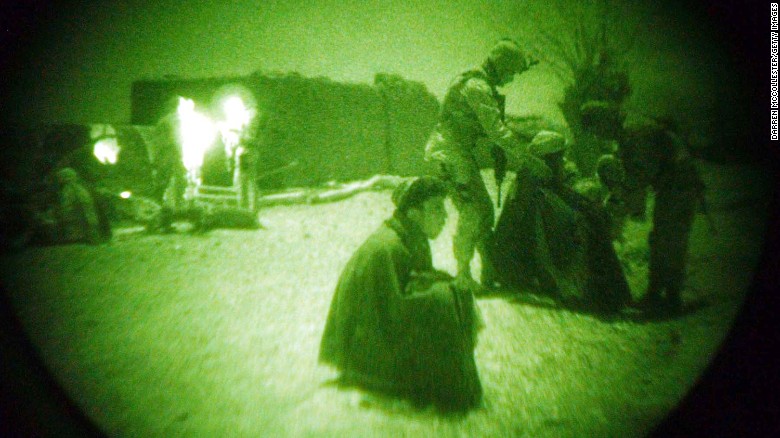
Photos: Afghanistan: America's longest war
A US soldier puts a blanket on a detainee during a mission in southeast Afghanistan in 2004. American troops went to fight in Afghanistan following the Sept. 11 terrorist attacks. The combat mission, code-named Operation Enduring Freedom, lasted for 13 years until being brought to an end in December 2014. Thousands of American troops are still in the country, however, as part of the NATO effort to train and advise Afghan security forces. Some US forces are also carrying out counterterrorism missions in the country.
Hide Caption
1 of 40
Photos: Afghanistan: America's longest war
In this image taken from video, US President George W. Bush addresses the nation from the White House on October 7, 2001. He announced that US and British forces had begun airstrikes on Taliban and al Qaeda targets in Afghanistan. The United States linked the Sept. 11 attacks to al Qaeda, a group that operated under the protection of the Taliban regime in Afghanistan. The military operation was launched to stop the Taliban from providing a safe haven to al Qaeda and to stop al Qaeda's use of Afghanistan as a base for terrorist activities.
Hide Caption
2 of 40
Photos: Afghanistan: America's longest war
Al Qaeda leader Osama bin Laden is seen at an undisclosed location in this television image broadcast on October 7, 2001. Bin Laden praised God for the Sept. 11 attacks and swore America "will never dream of security" until "the infidel's armies leave the land of Muhammad."
Hide Caption
3 of 40
Photos: Afghanistan: America's longest war
Soldiers with the Afghan Northern Alliance ride in a truck on October 19, 2001. They were opposition forces allied with the United States in its fight against the Taliban.
Hide Caption
4 of 40
Photos: Afghanistan: America's longest war
An aerial photo, released by the US Department of Defense on October 31, 2001, shows damage to a reported terrorist training camp in Afghanistan. US planes bombed the Taliban front line north of the Afghan capital of Kabul.
Hide Caption
5 of 40
Photos: Afghanistan: America's longest war
US Defense Secretary Donald Rumsfeld, right, speaks to the press during a Pentagon briefing on November 6, 2001. Rumsfeld said the United States had more than doubled the number of its troops based in Afghanistan. Other countries also contributed troops to the coalition.
Hide Caption
6 of 40
Photos: Afghanistan: America's longest war
Afghan refugees reach for bags of rice and sugar being handed out by a local aid organization near Chaman, Pakistan, on December 4, 2001. Tens of thousands of Afghans had crossed the border since the 9/11 attacks.
Hide Caption
7 of 40
Photos: Afghanistan: America's longest war
Al Qaeda prisoners are held in Agom, Afghanistan, on December 17, 2001. Afghan militia leaders declared victory in the battle of Tora Bora and claimed to have captured al Qaeda's last base.
Hide Caption
8 of 40
Photos: Afghanistan: America's longest war
A Northern Alliance fighter bursts into laughter as US planes strike a Taliban position near Tora Bora, Afghanistan, in December 2001.
Hide Caption
9 of 40
Photos: Afghanistan: America's longest war
A detainee is escorted by military police at the US naval base in Guantanamo Bay, Cuba, on February 6, 2002. The base's detention facilities had been repurposed to hold detainees from the US "war on terror."
Hide Caption
10 of 40
Photos: Afghanistan: America's longest war
Mullah Mohammed Omar, the man credited with creating the Taliban, is seen in this photo that spread in 2002. The Afghan government said in a news release that he died in Pakistan in 2013. The White House confirmed his death in 2015 but said "the exact circumstances of his death remain uncertain."
Hide Caption
11 of 40
Photos: Afghanistan: America's longest war
Mohboba, 7, stands near a bullet-ridden wall in Kabul as she waits to be seen at a health clinic on March 1, 2002. She had a skin ailment that plagued many poverty-stricken children in Afghanistan.
Hide Caption
12 of 40
Photos: Afghanistan: America's longest war
Damage is seen in Bamiyan, Afghanistan, where the Taliban destroyed the Buddhas of Bamiyan, the two tallest standing Buddhas in the world. The act generated an outcry in the international community. The Taliban also destroyed villages and towns in Bamiyan Province.
Hide Caption
13 of 40
Photos: Afghanistan: America's longest war
Afghan girls watch United Nations workers unload ballot kits ahead of the country's first democratic election in October 2004. Hamid Karzai was sworn in as President in December.
Hide Caption
14 of 40
Photos: Afghanistan: America's longest war
Afghan women walk past a portrait of Karzai in Kabul on October 26, 2004. Karzai had been in a leadership role since December 2001, when an interim government was formed after the Taliban lost its last major stronghold.
Hide Caption
15 of 40
Photos: Afghanistan: America's longest war
An Afghan soldier provides security near the site where a US helicopter crashed in Ghazni, Afghanistan, on April 7, 2005. At least 16 people were killed.
Hide Caption
16 of 40
Photos: Afghanistan: America's longest war
Protesters in Kabul rally against US President George W. Bush on May 12, 2005.
Hide Caption
17 of 40
Photos: Afghanistan: America's longest war
Poppy farmer Abdul Rassod looks over his field in Panshar, Afghanistan, on May 29, 2005. Afghanistan is the world's largest producer of opium and heroin.
Hide Caption
18 of 40
Photos: Afghanistan: America's longest war
Several people were killed in Kabul after a pair of suicide bombings on November 14, 2005.
Hide Caption
19 of 40
Photos: Afghanistan: America's longest war
Bush and Karzai attend a news conference in Kabul on March 1, 2006. It was Bush's first visit to Afghanistan.
Hide Caption
20 of 40
Photos: Afghanistan: America's longest war
US soldiers disembark from a helicopter in Afghanistan's Ghazni Province on May 28, 2007.
Hide Caption
21 of 40
Photos: Afghanistan: America's longest war
Supplies are dropped to US troops in Ghazni Province on May 29, 2007.
Hide Caption
22 of 40
Photos: Afghanistan: America's longest war
Afghan students recite Islamic prayers at an outdoor classroom in the remote Wakhan Corridor on September 2, 2007.
Hide Caption
23 of 40
Photos: Afghanistan: America's longest war
Troops wait to fire artillery on a Taliban position in Afghanistan's Kunar Province on October 22, 2008.
Hide Caption
24 of 40
Photos: Afghanistan: America's longest war
Bush speaks to US troops during an unannounced visit to Bagram Air Base on December 15, 2008. It was his second and last visit to Afghanistan as President.
Hide Caption
25 of 40
Photos: Afghanistan: America's longest war
US soldiers take defensive positions after receiving fire from Taliban positions in Afghanistan's Kunar Province on May 11, 2009. Army Spc. Zachary Boyd, left, was wearing "I love NY" boxer shorts after rushing from his sleeping quarters to join his fellow platoon members.
Hide Caption
26 of 40
Photos: Afghanistan: America's longest war
Afghan men cast their votes at a polling station in Kabul on August 20, 2009. It was the country's second election.
Hide Caption
27 of 40
Photos: Afghanistan: America's longest war
US Marines make their way up a mountainside in Afghanistan's Helmand Province on August 22, 2009.
Hide Caption
28 of 40
Photos: Afghanistan: America's longest war
Marines pay their respects to Lance Cpl. Joshua Bernard during his memorial service in Helmand Province on August 27, 2009. Bernard was killed during a Taliban ambush earlier that month.
Hide Caption
29 of 40
Photos: Afghanistan: America's longest war
US soldiers fire mortars from a base in Afghanistan's Kunar Province on October 24, 2009.
Hide Caption
30 of 40
Photos: Afghanistan: America's longest war
Afghan President Hamid Karzai prepares to kiss a copy of the Quran during his swearing-in ceremony on November 19, 2009. He won a second term after Foreign Minister Abdullah Abdullah dropped out of a runoff.
Hide Caption
31 of 40
Photos: Afghanistan: America's longest war
US President Barack Obama addresses troops at Bagram Air Base on March 28, 2010. A few months earlier, he announced a surge of 30,000 additional troops. This new deployment would bring the US total to almost 100,000 troops, in addition to 40,000 NATO troops.
Hide Caption
32 of 40
Photos: Afghanistan: America's longest war
US soldiers shield themselves from dust as a helicopter takes off in Afghanistan's Arghandab Valley on July 30, 2010.
Hide Caption
33 of 40
Photos: Afghanistan: America's longest war
Obama and members of his national security team monitor the mission against Osama bin Laden on May 1, 2011. Bin Laden was killed when Navy SEALs conducted a raid at a compound in Pakistan. (Editor's note: The classified document in front of Hillary Clinton was obscured by the White House.)
Hide Caption
34 of 40
Photos: Afghanistan: America's longest war
Obama announces the death of bin Laden on May 1, 2011.
Hide Caption
35 of 40
Photos: Afghanistan: America's longest war
Obama shakes the prosthetic hand of Army Sgt. 1st Class Leroy Arthur Petry on July 12, 2011. Petry was at the White House to receive the Medal of Honor. The Army Ranger lost his hand while tossing an enemy grenade away from fellow soldiers in Afghanistan.
Hide Caption
36 of 40
Photos: Afghanistan: America's longest war
A coalition helicopter fires flares in Kuz Kunar, Afghanistan, on July 17, 2011.
Hide Caption
37 of 40
Photos: Afghanistan: America's longest war
An Afghan soldier carries his wounded colleague to a US Army helicopter after a roadside bomb attack on the outskirts of Kandahar, Afghanistan, on July 29, 2011.
Hide Caption
38 of 40
Photos: Afghanistan: America's longest war
A US Army carry team moves the remains of Sgt. William B. Gross Paniagua at Dover Air Force Base in Delaware on August 1, 2011. Gross Paniagua died in Afghanistan on July 31, 2011, from injuries sustained by an improvised explosive device.
Hide Caption
39 of 40
Photos: Afghanistan: America's longest war
US Army Gen. John Campbell, left, and Command Sgt. Maj. Delbert Byers open the "Resolute Support" flag during a ceremony in Kabul on December 28, 2014. The United States and NATO formally ended the combat mission in Afghanistan. Resolute Support was the name of the new mission to assist and train Afghanistan's troops.
Hide Caption
40 of 40

Photos: Afghanistan: America's longest war
A US soldier puts a blanket on a detainee during a mission in southeast Afghanistan in 2004. American troops went to fight in Afghanistan following the Sept. 11 terrorist attacks. The combat mission, code-named Operation Enduring Freedom, lasted for 13 years until being brought to an end in December 2014. Thousands of American troops are still in the country, however, as part of the NATO effort to train and advise Afghan security forces. Some US forces are also carrying out counterterrorism missions in the country.
Hide Caption
1 of 40
Photos: Afghanistan: America's longest war
In this image taken from video, US President George W. Bush addresses the nation from the White House on October 7, 2001. He announced that US and British forces had begun airstrikes on Taliban and al Qaeda targets in Afghanistan. The United States linked the Sept. 11 attacks to al Qaeda, a group that operated under the protection of the Taliban regime in Afghanistan. The military operation was launched to stop the Taliban from providing a safe haven to al Qaeda and to stop al Qaeda's use of Afghanistan as a base for terrorist activities.
Hide Caption
2 of 40
Photos: Afghanistan: America's longest war
Al Qaeda leader Osama bin Laden is seen at an undisclosed location in this television image broadcast on October 7, 2001. Bin Laden praised God for the Sept. 11 attacks and swore America "will never dream of security" until "the infidel's armies leave the land of Muhammad."
Hide Caption
3 of 40
Photos: Afghanistan: America's longest war
Soldiers with the Afghan Northern Alliance ride in a truck on October 19, 2001. They were opposition forces allied with the United States in its fight against the Taliban.
Hide Caption
4 of 40
Photos: Afghanistan: America's longest war
An aerial photo, released by the US Department of Defense on October 31, 2001, shows damage to a reported terrorist training camp in Afghanistan. US planes bombed the Taliban front line north of the Afghan capital of Kabul.
Hide Caption
5 of 40
Photos: Afghanistan: America's longest war
US Defense Secretary Donald Rumsfeld, right, speaks to the press during a Pentagon briefing on November 6, 2001. Rumsfeld said the United States had more than doubled the number of its troops based in Afghanistan. Other countries also contributed troops to the coalition.
Hide Caption
6 of 40
Photos: Afghanistan: America's longest war
Afghan refugees reach for bags of rice and sugar being handed out by a local aid organization near Chaman, Pakistan, on December 4, 2001. Tens of thousands of Afghans had crossed the border since the 9/11 attacks.
Hide Caption
7 of 40
Photos: Afghanistan: America's longest war
Al Qaeda prisoners are held in Agom, Afghanistan, on December 17, 2001. Afghan militia leaders declared victory in the battle of Tora Bora and claimed to have captured al Qaeda's last base.
Hide Caption
8 of 40
Photos: Afghanistan: America's longest war
A Northern Alliance fighter bursts into laughter as US planes strike a Taliban position near Tora Bora, Afghanistan, in December 2001.
Hide Caption
9 of 40
Photos: Afghanistan: America's longest war
A detainee is escorted by military police at the US naval base in Guantanamo Bay, Cuba, on February 6, 2002. The base's detention facilities had been repurposed to hold detainees from the US "war on terror."
Hide Caption
10 of 40
Photos: Afghanistan: America's longest war
Mullah Mohammed Omar, the man credited with creating the Taliban, is seen in this photo that spread in 2002. The Afghan government said in a news release that he died in Pakistan in 2013. The White House confirmed his death in 2015 but said "the exact circumstances of his death remain uncertain."
Hide Caption
11 of 40
Photos: Afghanistan: America's longest war
Mohboba, 7, stands near a bullet-ridden wall in Kabul as she waits to be seen at a health clinic on March 1, 2002. She had a skin ailment that plagued many poverty-stricken children in Afghanistan.
Hide Caption
12 of 40
Photos: Afghanistan: America's longest war
Damage is seen in Bamiyan, Afghanistan, where the Taliban destroyed the Buddhas of Bamiyan, the two tallest standing Buddhas in the world. The act generated an outcry in the international community. The Taliban also destroyed villages and towns in Bamiyan Province.
Hide Caption
13 of 40
Photos: Afghanistan: America's longest war
Afghan girls watch United Nations workers unload ballot kits ahead of the country's first democratic election in October 2004. Hamid Karzai was sworn in as President in December.
Hide Caption
14 of 40
Photos: Afghanistan: America's longest war
Afghan women walk past a portrait of Karzai in Kabul on October 26, 2004. Karzai had been in a leadership role since December 2001, when an interim government was formed after the Taliban lost its last major stronghold.
Hide Caption
15 of 40
Photos: Afghanistan: America's longest war
An Afghan soldier provides security near the site where a US helicopter crashed in Ghazni, Afghanistan, on April 7, 2005. At least 16 people were killed.
Hide Caption
16 of 40
Photos: Afghanistan: America's longest war
Protesters in Kabul rally against US President George W. Bush on May 12, 2005.
Hide Caption
17 of 40
Photos: Afghanistan: America's longest war
Poppy farmer Abdul Rassod looks over his field in Panshar, Afghanistan, on May 29, 2005. Afghanistan is the world's largest producer of opium and heroin.
Hide Caption
18 of 40
Photos: Afghanistan: America's longest war
Several people were killed in Kabul after a pair of suicide bombings on November 14, 2005.
Hide Caption
19 of 40
Photos: Afghanistan: America's longest war
Bush and Karzai attend a news conference in Kabul on March 1, 2006. It was Bush's first visit to Afghanistan.
Hide Caption
20 of 40
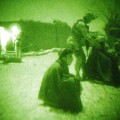
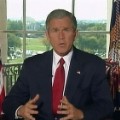
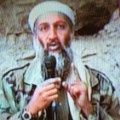
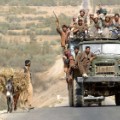

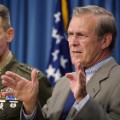
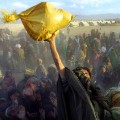
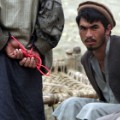
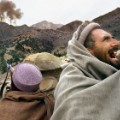
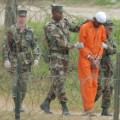
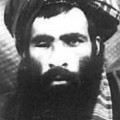



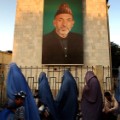
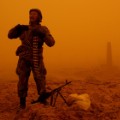
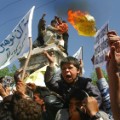
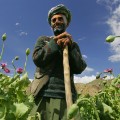
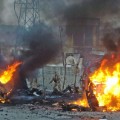
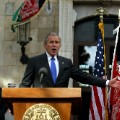
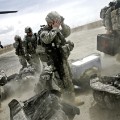
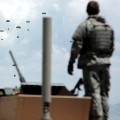
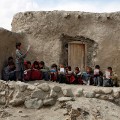

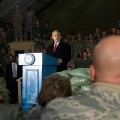
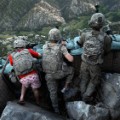
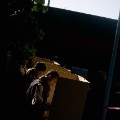

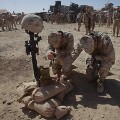

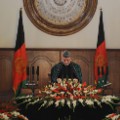
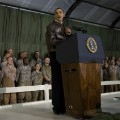
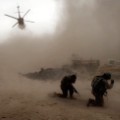
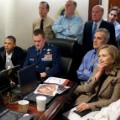
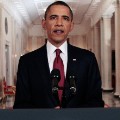
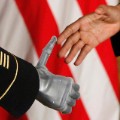
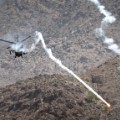
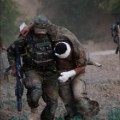
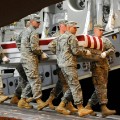
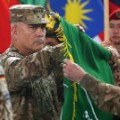
New US strategy took time
Trump has previously expressed reservations about the seemingly endless US military commitment in Afghanistan and questioned the objectives of staying there.
The President reached a decision on the future of the US strategy in Afghanistan on Friday after months of deliberation.
Trump's decision comes as Taliban militants have been resurgent in recent months, posting a series of recent gains against Afghan government forces, which are backed by a US-led coalition of NATO allies.
The United States first invaded Afghanistan on October 7, 2001, as part of Operation Enduring Freedom.
The Bush administration accused the country's then Taliban government of sheltering al Qaeda leader Osama Bin Laden, who had masterminded the previous month's September 11 terrorist attacks.
The Taliban offered to hand over Bin Laden for trial, but only to a third country, rather than directly to the United States. Washington refused the offer and launched air and ground attacks, joined shortly thereafter by US allies.
CNN's Steve George, Ben Westcott and Jeremy Diamond contributed to this report.
News Courtesy: www.cnn.com

